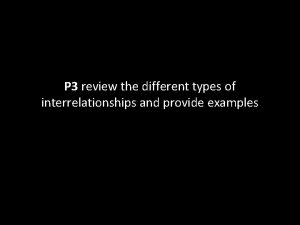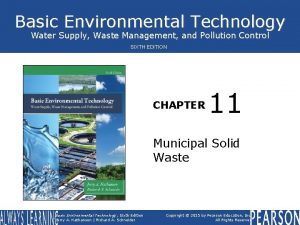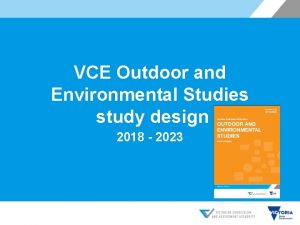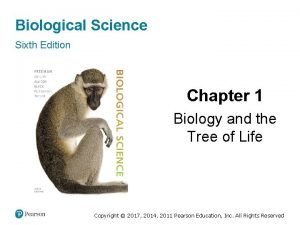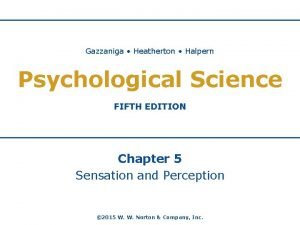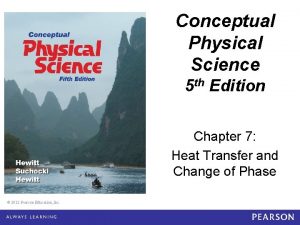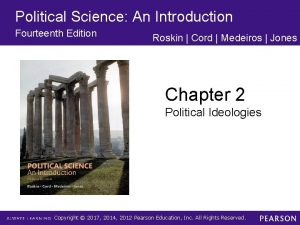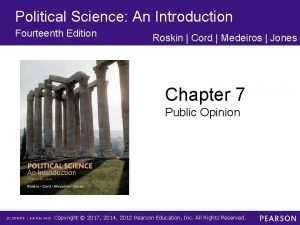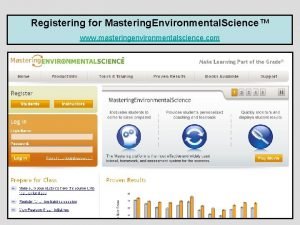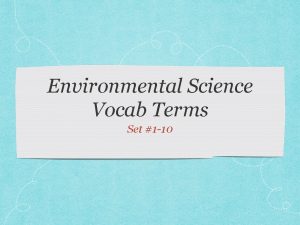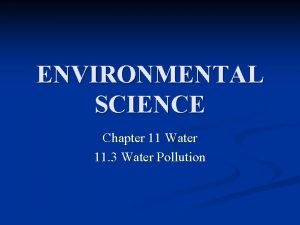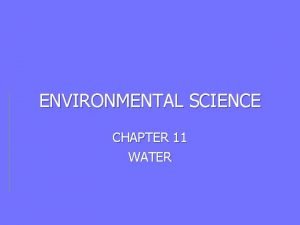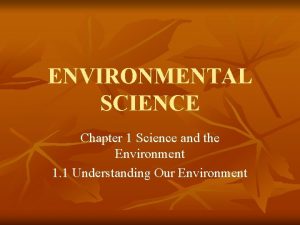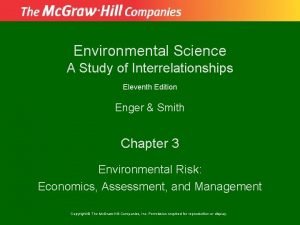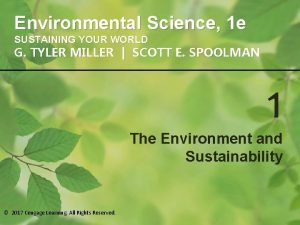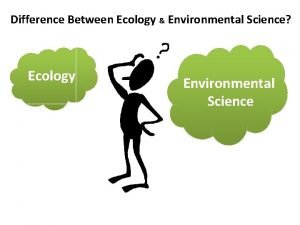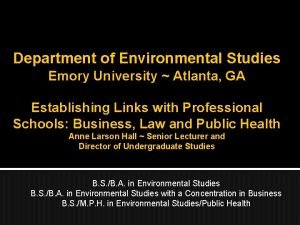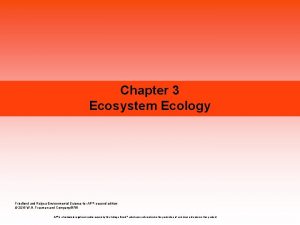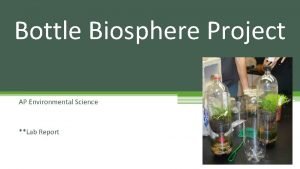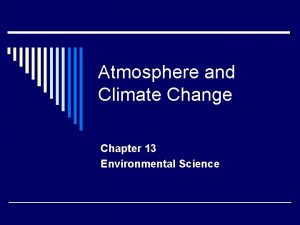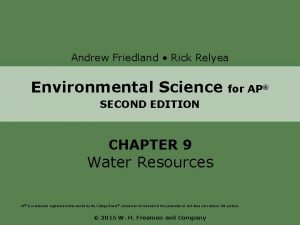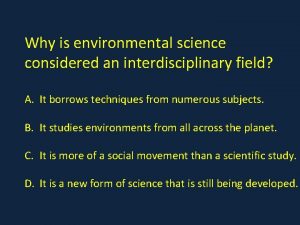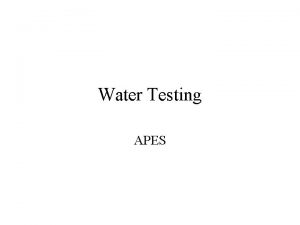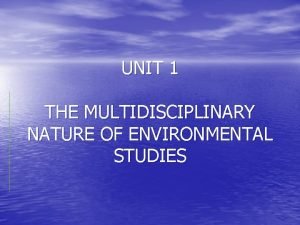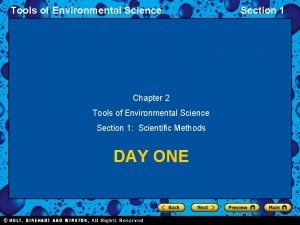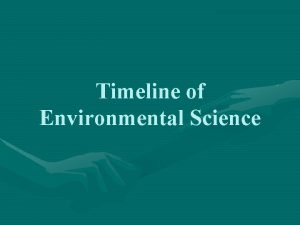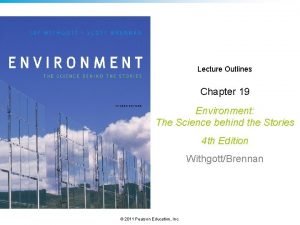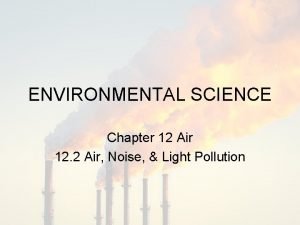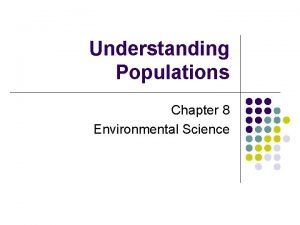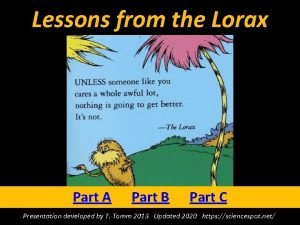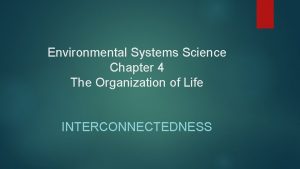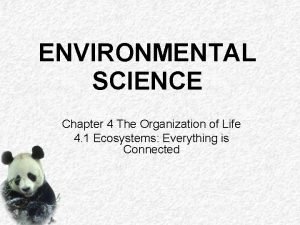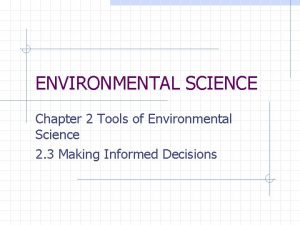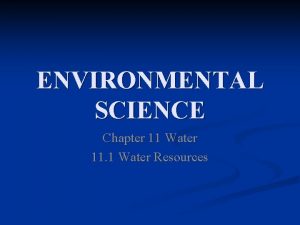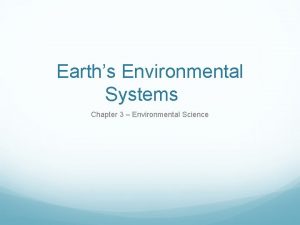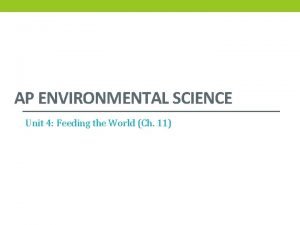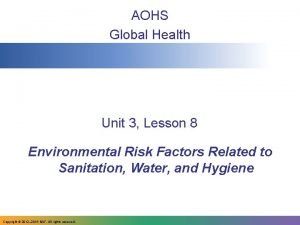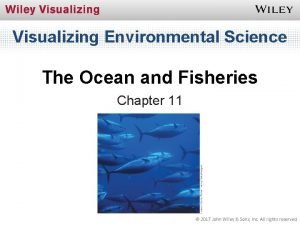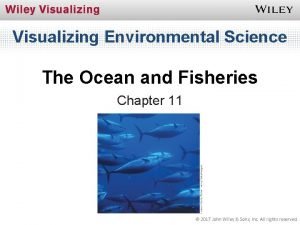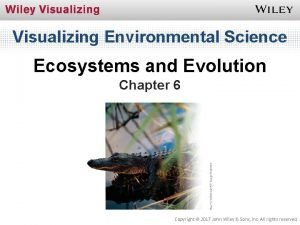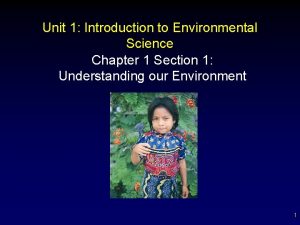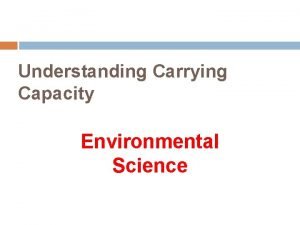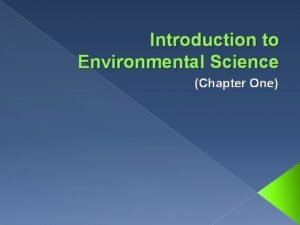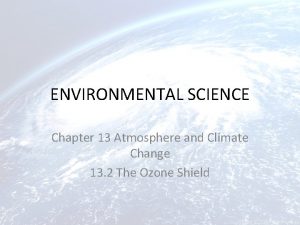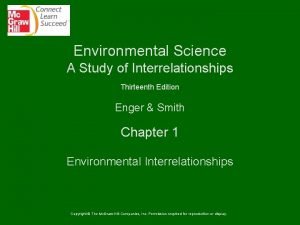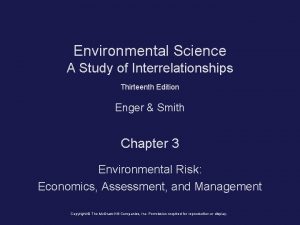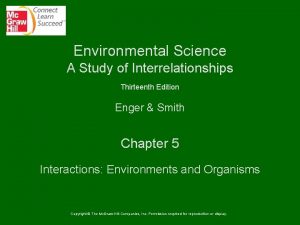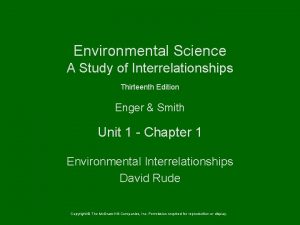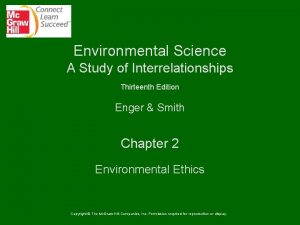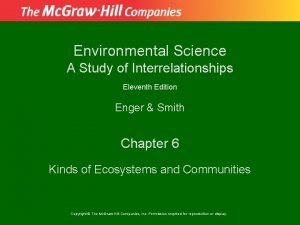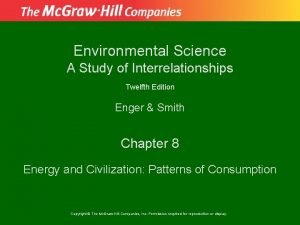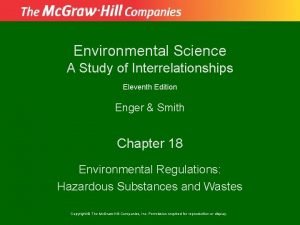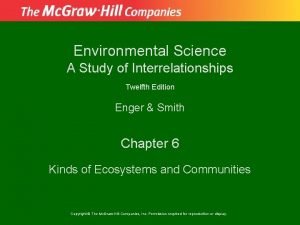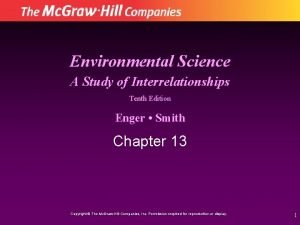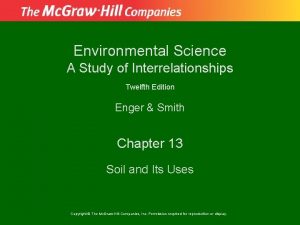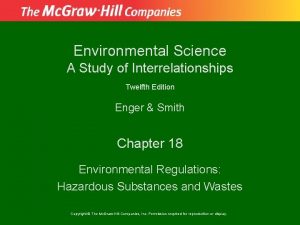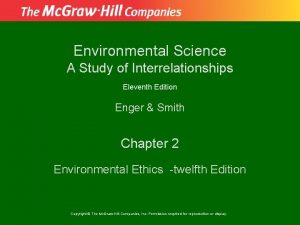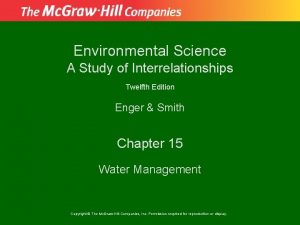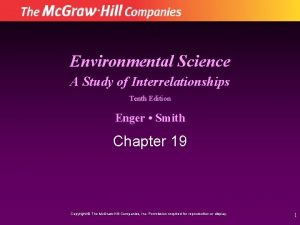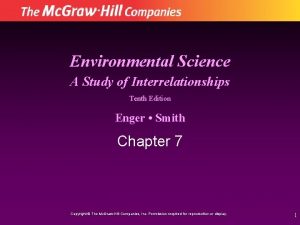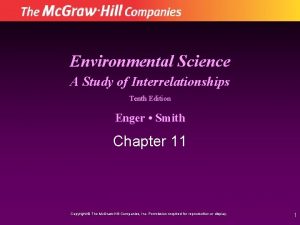Environmental Science A Study of Interrelationships Thirteenth Edition






































































- Slides: 70

Environmental Science A Study of Interrelationships Thirteenth Edition Enger & Smith Chapter 11 Biodiversity Issues Copyright © The Mc. Graw-Hill Companies, Inc. Permission required for reproduction or display.

Biodiversity Issues

Outline § § 11. 1 Biodiversity Loss and Extinction 11. 2 The Value of Biodiversity 11. 3 Threats to Biodiversity 11. 4 What Is Being Done to Preserve Biodiversity?

11. 1 Biodiversity Loss and Extinction § Biodiversity is a broad term used to describe the diversity of genes, species, and ecosystems in a region. § Extinction is the elimination of all the individuals of a particular species. • Extinction is a natural and common event in the history of biological evolution. • It, and the resulting loss of biodiversity, is also a major consequence of human domination of the Earth.

11. 1 Biodiversity Loss and Extinction § Over the past few hundred years, humans are estimated to have increased the extinction rate by a factor of 1, 000 to 10, 000 times above background rates typical over the planet’s history. • 1/8 of bird species, 1/4 of mammal species, 1/3 of amphibian species, and 1/2 of turtle species are threatened. • 10% of the world’s coral reefs have been lost. • Mangrove forests are reduced by over 1% a year. • 25% of global land is used to raise crops.

11. 1 Biodiversity Loss and Extinction § Local extinctions, although relatively common, indicate the future of a species is not encouraging. § As population is reduced in size, some of the genetic diversity is likely to be lost. § Certain kinds of species are more likely to go extinct than others: • Species with small, dispersed populations – Successful breeding is difficult.

11. 1 Biodiversity Loss and Extinction • Organisms in small, restricted areas, such as islands. – Environmental changes have large effect. • Specialized organisms – Relying on constancy of a few key factors. • Organisms at higher trophic levels. – Low population sizes and reproductive rates.

11. 1 Biodiversity Loss and Extinction

11. 1 Biodiversity Loss and Extinction § As human populations grew, and their tools became more advanced, the impact a single human could have on surroundings increased. § Environmental modifications allowed larger, dense human populations to survive, but at the expense of previously existing ecosystems. § Nearly all the Earth’s surface has been affected in some way by human activity.

Genetic Diversity § Genetic diversity is a term used to describe the number of kinds of genes present in a population. • High genetic diversity indicates many different kinds of genes present in individuals of a population. • Low genetic diversity indicates nearly all individuals share the same genes and therefore the same characteristics.

Genetic Diversity § Several things influence a population’s genetic diversity: • Mutations introduce new genetic information into a population by modifying current genes. • Migration allows movement of genes from one population to another. • Sexual reproduction generates new genetic combinations.

Genetic Diversity • Population size is an important factor: The smaller the population, the less genetic diversity it can contain. – There are fewer variations for each characteristic. – Random events can significantly alter the genetic diversity in small populations. • Selective breeding can affect diversity because undesirable characteristics are eliminated. – Many domesticated plants and animals could not survive without human help.

Species Diversity § Species diversity is a measure of the number of different species present in an area. • Species richness refers to the number of different kinds of species in an area. • Taxonomic richness takes into account the number of different taxonomic categories of the species present.

Species Diversity § When humans exploit an area, they influence species diversity. • They convert natural ecosystems to human-managed ecosystems. – They harvest certain species for their use. – They specifically eliminate species that compete with desirable species. – They introduce nonnative species to an area.

Species Diversity § Estimates of the actual number of species range from a few million to 100 million. • About 1. 4 million species have been described. – Many species are naturally rare, and others live in areas difficult to reach.

Ecosystem Diversity § Ecosystem diversity is a measure of the number of kinds of ecosystems present in an area. § Many regions of the world appear to be quite uniform in terms of the kinds of ecosystems present. • For example, many parts of the world are deserts: – While there are general similarities, each is different and has specific organisms typical to the region. – Local topographic conditions create unique patches of landscape.

11. 2 The Value of Biodiversity § Biological and Ecosystem Services Values § Humans are totally dependent on the diversity of organisms on Earth. • Symbiotic nitrogen-fixing bacteria live in the roots of certain plants. • Spoil-building organisms live on the dead organic matter provided by plants and animals. • It is impossible for organisms to function optimally unless it has its supporting cast of players that are part of the ecosystem.

11. 2 The Value of Biodiversity § Nutrient cycling • Carbon, nitrogen, phosphorus, and other chemical elements are cycled through ecosystems. § Cultural Uses • Enjoyment of landscapes, individual organisms, scientific study, educational activities, and the spiritual significance of places. § Water regulation and supply • Intact soil and vegetation slow water flow, allowing it to penetrate the soil and recharge aquifers. • Water is available for agriculture, industry, and domestic use.

11. 2 The Value of Biodiversity § Disturbance regulation and erosion control • Land can be disturbed by fire, flood, windstorms, landslides, or human actions. • Colonization of these sites by plants and animals heals the scars and prevents continued damage. § Waste Treatment • Decomposer organisms remove excess nutrients and pollutants from air, water, and soil. § Food and Raw Materials • Many people harvest wild plants and animals as food and medicine. Plants feed livestock, provide building materials, and firewood.

11. 2 The Value of Biodiversity § Atmospheric and Climate Services • Many atmospheric gases are cycled between organisms and the atmosphere. – Removal of carbon dioxide in photosynthesis helps control the warming of the planet. – Nitrogen and sulfur are modified by organisms. – Ozone provides protection from UV light. § Recreation • Natural areas provide recreational opportunities. § Biological Control Services • All organisms have complex interrelationships. Some help remove pests.

11. 2 The Value of Biodiversity § Pollination Services • Many insects are pollinators. Careless use of insecticides can negatively affect agricultural production. § Habitat/Refuges • Refuges protect species, serve as nursery sites, and provide temporary stopping places for migratory species.

11. 2 The Value of Biodiversity § Genetic Resources • If an organism goes extinct, we have lost the ability to use it for our own needs. • Wild ancestors of our food grains are thought to be extinct. • 50% of our common drugs come from plants and animals. § Soil Formation • Weathering of rock, aided by bacteria, fungi, tiny animals, and plants roots build soil. • Our food supply depends on the protection and management of soil.

11. 2 The Value of Biodiversity § Choices between competing uses for ecosystems are often determined by economic values. • Value can be assigned to services provided by intact, functioning ecosystems. – A 1997 study estimates $33 trillion per year, but that figure may be low. • Some resources are difficult to assign specific monetary value: – Wildlife (consumed by those who harvest it) – Medicinal plants

11. 2 The Value of Biodiversity § A case can be made that all species have an intrinsic value and a fundamental right to exist. • Extinction is not necessarily bad, but human-initiated extinction is. • Experiencing natural landscapes and processes is an important human right.

11. 2 The Value of Biodiversity § The values held by a person are typically shaped by experience. • As the shift from rural to urban continues, there is continual erosion of natural experiences that can shape the values of people. • These values are important in determining how society will approach threats to biodiversity.

11. 3 Threats to Biodiversity § Five major human activities threaten to reduce biodiversity. • • • Habitat loss Overexploitation Introduction of exotic species Predator and pest control activities Climate change

11. 3 Threats to Biodiversity § The International Union for Conservation of Nature and Natural Resources (IUCN) estimates that 80%90% of threatened species are under threat as a result of habitat loss or fragmentation. § Habitat loss and fragmentation are thought to be a major cause of past extinctions.

11. 3 Threats to Biodiversity § About 40% of the world’s land surface has been converted to cropland permanent pasture. § Typically, the most productive natural ecosystems (forests and grasslands) are the first to be modified by humans. § Pressures to modify the environment are greatest in areas with high population density.

11. 3 Threats to Biodiversity § Originally, half of the U. S. , three-fourths of Canada, and almost all of Europe, and significant portions of the rest of the world were forested. § Deforestation is the process of destroying a forest, often for the purposes of fuel, building materials, or to clear land for farming.

11. 3 Threats to Biodiversity § Modern forest management practices involve a compromise that allows economic exploitation while maintaining some environmental values of the forest. • Forested areas effectively: – Reduce erosion. – Reduce runoff. – Modify the climate. – Provide recreational opportunities.

11. 3 Threats to Biodiversity Changes in forest area

11. 3 Threats to Biodiversity § Clear cutting is the removal of all trees in an area. It is economical but increases erosion, especially on steep slopes. § Patchwork clear cutting is clear cutting in small, unconnected patches; preserves biodiversity. § Selective harvesting is single species tree harvesting. It is not as economical, but reduces ecosystem damage.

11. 3 Threats to Biodiversity Clear cutting

11. 3 Threats to Biodiversity § Tropical forests have greater species diversity than any other ecosystem. § They are not as likely as temperate forests to regenerate after logging due to poor soil characteristics. § Currently, few tropical forests are being managed for long-term productivity.

11. 3 Threats to Biodiversity § Several concerns are raised by tropical deforestation: • • It significantly reduces species diversity in the world. It impacts the climate via lowered transpiration. Deforested lands are easily eroded. Without the forests to trap CO 2, there may be increased global warming. • Human population pressure is greatest in tropics, and still increasing.

11. 3 Threats to Biodiversity § Many lumber companies maintain forest plantations as crops and manage them in the same way farmers manage crops. • Plant single species, even-aged forests of fast growing hybrid trees. • Competing species are controlled by fire, and insects controlled by spraying. • Trees mature to harvestable size in as low as 20 years (vs. 100). – Quality of lumber reduced. – Low species diversity and wildlife value.

11. 3 Threats to Biodiversity § Rangelands are lands too dry to support crops, but receive enough precipitation to support grasses and drought-resistant shrubs. § They are often used to raise low-density populations of domesticated or semidomesticated animals. § Wildlife are usually introduced species not native to the region.

11. 3 Threats to Biodiversity Use of rangelands

11. 3 Threats to Biodiversity § The conversion of rangelands to grazing by domesticated animals has major impacts on biodiversity. • Selective eating habits of livestock tend to reduce certain species of native plants and encourage others. • Important to regulate number of livestock on rangelands, especially in dry areas. – Overgrazing is a severe problem where human population pressures are great. – Desertification is the process of converting arid or semiarid land to desert because of improper human use.

11. 3 Threats to Biodiversity Desertification

11. 3 Threats to Biodiversity § In marine ecosystems, much of the harvest is restricted to shallow parts of the ocean where bottom-dwelling fish can be easily harvested. § Trawls are nets dragged along the bottom. • They disturb the seafloor and cause habitat damage. § About 25% of catch is undesirable, and thus discarded, but they are usually dead, and their removal further alters the ecological nature of the seafloor.

Habitat Loss in Aquatic Ecosystems § Freshwater systems are often modified for navigation, irrigation, flood control, or power production. § All of these processes may alter natural ecosystems and change numbers or kinds of aquatic organisms present.

11. 3. B Threats to Biodiversity § About 4. 3% of U. S. land is developed as urban centers, industrial sites, and transportation infrastructure. • Many areas are covered with impermeable surfaces that prevent plant growth and divert rainfall. • The trend is toward greater urbanization.

11. 3 Threats to Biodiversity § According to the IUCN, overexploitation is responsible for over 30% of endangered animal species and 8% of endangered plant species. • Overexploitation occurs when humans harvest organisms faster than the organisms are able to reproduce, threatening some, and causing extinction in others.

11. 3 Threats to Biodiversity § U. N. estimates 70% of world’s marine fisheries are overexploited or are fully exploited and in danger of being overexploited. • Amount of fish caught has remained relatively constant, while the amount produced by fish farming has increased. • The commercial fishing industry has been attempting to market species previously regarded as unacceptable.

11. 3 Threats to Biodiversity § Fish farming (aquaculture) is becoming increasingly important as a source of fish production. § Currently, about 60% of all aquaculture production is from freshwater systems. § The environmental impacts are similar to those of marine systems: • Nutrient overloads • Escape into natural waters • Land conversion

11. 3 Threats to Biodiversity § Meat from wild animals is often referred to as bush meat. § The Wildlife Conservation Society estimates 70% of wildlife species in Asia and Africa and about 40% of species in Latin America are being hunted unsustainably. • Hunting of wildlife is a part of all subsistence cultures. • Many kinds of wildlife are considered delicacies and are highly prized for the home and restaurant trade.

11. 3 Threats to Biodiversity § Harvest of living animals for the pet and aquarium trade is a significant problem. • The method of capture is often problematic. – Destruction of bird nests. – Toxins used to stun fish. § Wildlife are also hunted because parts of the animal may have particular value. – Ivory and animal skins – Traditional medicines

11. 3 Threats to Biodiversity § Some introductions of exotic species are purposeful, while others are accidental. § Globalization is responsible for spreading thousands of invasive alien species around the world. § The IUCN estimates about 30% of birds and 15% of plants are threatened because they are unable to successfully compete against invasive exotic species.

11. 3 Threats to Biodiversity § Introduction of disease has had considerable impact on American forests. • Chestnut blight • Dutch elm disease § Various insects have had an effect on ecosystem structure. • Asian long horned beetle § Freshwater ecosystems have been greatly affected. • Zebra mussel

11. 3 Threats to Biodiversity The Asian long horned beetle

11. 3 Threats to Biodiversity § Systematic killing of certain organisms that interfere with human activities also results in reduced biodiversity. • Large predators have been locally exterminated because they preyed on domestic animals. • Passenger pigeons became extinct primarily because of increased conversion of forested land.

11. 3 Threats to Biodiversity § Predator and competitor control activities have been largely eliminated in North America. • It is generally not considered to be cost-effective in most cases. – Hunting and trapping of wolves in Alaska and Canada is an exception. – Control of cowbird populations has been used to enhance breeding success of Kirtland’s warblers.

11. 3 Threats to Biodiversity § The role of climate change on the survival of species has become an issue. • Many species live near the limit of their physiological tolerance. A slight change in the temperature may push them over the brink. • Amphibians, corals, and arctic species are greatly affected by climate change. – Planet warming may have caused a fungal disease in frogs. – Melting sea ice is changing migration patterns and food availability.

11. 3 Threats to Biodiversity

11. 4 What Is Being Done to Preserve Biodiversity? § The World Conservation Union (IUCN) lists over 16, 000 species as threatened with extinction. • IUCN classifies species in danger of extinction into four categories: – Endangered – Vulnerable – Rare – Indeterminate

11. 4 What Is Being Done to Preserve Biodiversity? § Awareness and concern about loss of biodiversity are high in many developed countries. § Most vulnerable species in these areas have already been eliminated. § Loss of biodiversity is not a high priority for the general public in developing countries. § They are more concerned with immediate needs of food and shelter than long-range issues such as species extinction.

11. 4 What Is Being Done to Preserve Biodiversity? § In the U. S. , the primary action related to the preservation of biodiversity involved the passage of the Endangered Species Act (1973). § This legislation designates species as endangered or threatened and gives the U. S. government jurisdiction over those species. • Directs that no activity by a government agency should lead to the extinction of an endangered species. • Directs government agencies to use whatever means necessary to preserve the species in question.

11. 4 What Is Being Done to Preserve Biodiversity? § Endangered species are those that have such small numbers that they are in immediate danger of becoming extinct. § Threatened species could become extinct if a critical environmental factor is changed. • The preservation question ultimately becomes one of assigning value to the species. • Amendments to ESA have weakened ability of U. S. government to add new species to the list.

11. 4 What Is Being Done to Preserve Biodiversity? § Habitat Analysis and Management • Managing a particular species requires an understanding of the habitat needs of that species. • An animal’s habitat must provide food, water, and cover. – Cover conceals or protects animals from the elements or enemies. • Modifications made to enhance the success of a species are known as habitat management.

11. 4 What Is Being Done to Preserve Biodiversity? § Game species are often managed so they do not exceed carrying capacity of their habitat. § Wildlife managers use population censuses to check if populations are within appropriate levels. § With suitable habitat and protection, most wild animals can maintain a sizeable population. § High reproductive capacities and heavy protection have caused very large populations to arise from once-rare animals.

11. 4 What Is Being Done to Preserve Biodiversity? § Wildlife management often involves harvesting for sport and meat. • Regulating hunting activity is an important population management technique. • Seasons usually occur in the fall so surplus animals are taken before the challenges of winter. § When populations get too small, artificial introductions can be implemented. • Native species can be reintroduced to areas where they had been extinct. • Non-native species are introduced for empty niches.

11. 4 What Is Being Done to Preserve Biodiversity? Managing a wildlife population

11. 4 What Is Being Done to Preserve Biodiversity? § Migratory birds can travel thousands of kilometers. • They travel north in spring to reproduce. • They travel south in fall to escape cold temperatures. § International agreements may be necessary to maintain appropriate habitat.

11. 4 What Is Being Done to Preserve Biodiversity? Migration routes for North American waterfowl

11. 4 What Is Being Done to Preserve Biodiversity? § Coastal regions are most productive regions of the oceans. • Sunlight penetration of shallow water makes it warm. • Nutrient deposition from land makes this region fertile. • Wind/wave action stirs nutrients. § Fishing pressure is concentrated here. § One of the major problems associated with the management of marine fisheries is achieving agreement on harvest limits.

11. 4 What Is Being Done to Preserve Biodiversity? § Humans have easy access to freshwater ecosystems, so management of these systems is much more intense. § They are typically easier to regulate because of containment within a smaller political region. § Many North American freshwater fisheries are primarily managed for sport fishery. § Fisheries’ biologists pay special attention to water quality.

Summary § Loss of biodiversity has become a major concern. § Ecosystems involve the interactions of organisms and their physical environment. § Functioning ecosystems and their component organisms provide many valuable services that are often overlooked because they are not easily measured in economic terms.

Summary § Many people also consider the loss of biodiversity to be an ethical problem. § The primary causes of habitat loss are by: • Humans converting ecosystems to agriculture and grazing. • Overexploitation by harvesting species at unsustainable levels. • Introduction of exotic species that disrupt ecosystems and compete or prey on native organisms. • Purposeful killing of pest organisms such as large predators.

Summary § Protection of biodiversity typically involves legal protections by national laws and international agreements, and management of the use of species and ecosystems at sustainable levels.
 Pa state tree
Pa state tree Tui interrelationships
Tui interrelationships Rule of 70 population growth
Rule of 70 population growth My favorite subject science
My favorite subject science Mis chapter 6
Mis chapter 6 Mis
Mis Basic environmental technology
Basic environmental technology Wireless health
Wireless health Prehospital emergency care 11th edition study guide
Prehospital emergency care 11th edition study guide Outdoor and environmental studies
Outdoor and environmental studies Chemistry: the central science chapter 14 answers
Chemistry: the central science chapter 14 answers Biological science 6th edition
Biological science 6th edition Rotating snake illusion
Rotating snake illusion When air rapidly expands its temperature normally
When air rapidly expands its temperature normally Conceptual physical science 5th edition
Conceptual physical science 5th edition Conceptual physical science 5th edition
Conceptual physical science 5th edition The fundamentals of political science research 2nd edition
The fundamentals of political science research 2nd edition Political science 14th edition
Political science 14th edition Political science 14th edition
Political science 14th edition Science power 9 atlantic edition
Science power 9 atlantic edition Ap environmental science exam pass rate
Ap environmental science exam pass rate Tragedy of the commons easter island
Tragedy of the commons easter island Environmental science subject code
Environmental science subject code Mastering ap environmental science
Mastering ap environmental science Environmental science defination
Environmental science defination Hudacko
Hudacko Water pollution objectives
Water pollution objectives Water that contains wastes from homes or industry
Water that contains wastes from homes or industry Environmental science chapter 1
Environmental science chapter 1 Tragedy of commons environmental science
Tragedy of commons environmental science Environmental science sustaining your world answers
Environmental science sustaining your world answers Ecology and environmental science difference
Ecology and environmental science difference Emory environmental science
Emory environmental science Npp environmental science
Npp environmental science Ap environmental science lab
Ap environmental science lab Chapter 13 review environmental science
Chapter 13 review environmental science Environmental jeopardy
Environmental jeopardy Friedland and relyea environmental science
Friedland and relyea environmental science A science is considered interdisciplinary when weegy
A science is considered interdisciplinary when weegy Water quality tests apes
Water quality tests apes Multidisciplinary nature of environmental studies
Multidisciplinary nature of environmental studies Chapter 2 assessment environmental science answers
Chapter 2 assessment environmental science answers Environmental science timeline
Environmental science timeline National 5 environmental science
National 5 environmental science Environmental chemistry science olympiad
Environmental chemistry science olympiad Chapter 19 environmental science
Chapter 19 environmental science Environmental science chapter 2
Environmental science chapter 2 Radonrid
Radonrid Environmental science
Environmental science Chapter 8 environmental science
Chapter 8 environmental science Tools of environmental science
Tools of environmental science The lorax part 1
The lorax part 1 Chapter 4 environmental science
Chapter 4 environmental science Environmental science chapter 4 the organization of life
Environmental science chapter 4 the organization of life Chapter 2 assessment environmental science
Chapter 2 assessment environmental science Water table environmental science
Water table environmental science Earth's environmental systems chapter 3
Earth's environmental systems chapter 3 Environmental science chapter 10 review answers
Environmental science chapter 10 review answers Limestone ridges built by tiny animals
Limestone ridges built by tiny animals Ap environmental science aquatic biomes
Ap environmental science aquatic biomes Unit 4 ap environmental science
Unit 4 ap environmental science Pearson
Pearson Environmental science unit 1 lesson 8
Environmental science unit 1 lesson 8 Visualizing environmental science solution manual
Visualizing environmental science solution manual Visualizing environmental science solution manual
Visualizing environmental science solution manual Visualizing environmental science (doc or html) file
Visualizing environmental science (doc or html) file Unit 1 introduction to environmental science
Unit 1 introduction to environmental science Carrying capacity graph
Carrying capacity graph Environmental science bell ringers
Environmental science bell ringers Chapter 13 environmental science
Chapter 13 environmental science Earth system graphic organizer
Earth system graphic organizer

